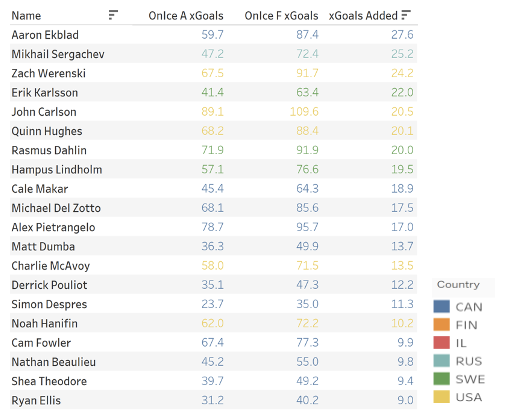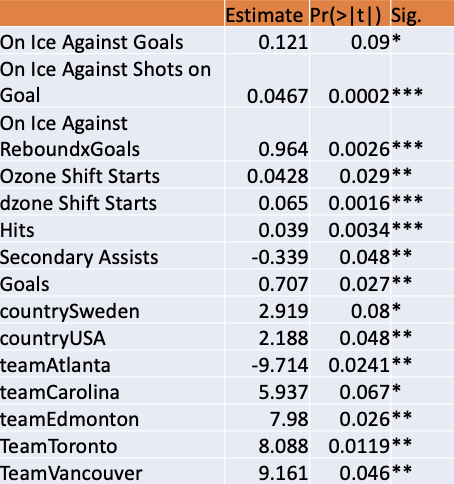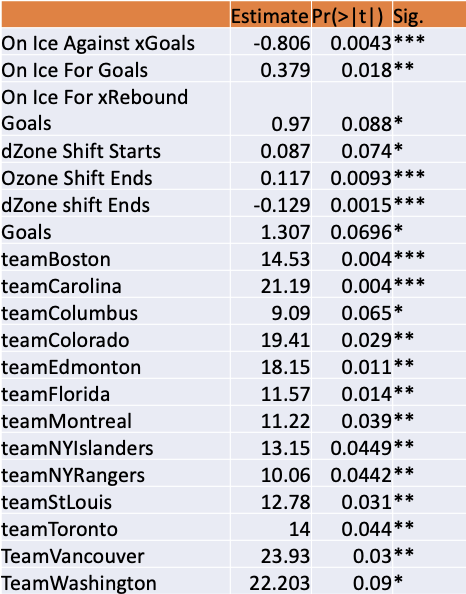By Justin Philbin – Syracuse University ’21
Abstract
The purpose of this research was to try to determine if there was any underlying benefit or consequences to drafting defensemen from outside of North America in the first round. I wanted to explore this topic because I was curious to see if statistically, European defenseman translated to the NHL better than North Americans. Ice surfaces in Europe are about fifty feet wider than those in North America so they maybe better at covering more of the ice, more effectively. Also in today’s game, there are many more players from Europe in the NHL, so maybe this was part of the reason why. The dataset for this experiment contains all of the first-round picks in the NHL draft who were defensemen from 2008 to 2019. This set of years was chosen because it was easily available from moneypuck.com.

Background
Thirty years ago, there was a stigma among NHL teams, that in large part, most did not like to draft European born players, because they were either believed to be less talented, or more difficult to develop. One reason for this is because it was much more difficult and expensive to spend time scouting all the European countries. Players then had to adjust to new surroundings, and potentially speaking a different language. These factors all made it discouraging to look at European prospects.
Today this stigma has dissipated as plenty of European born players have been drafted and developed into some of the best players the league has seen. Some of the best players currently in the NHL are European born, including defenseman who are in a unique position because many European leagues play on larger ice surfaces than the NHL. This brings up the question of does playing on a larger ice surface lead to greater success for European defenseman because of the shift to a smaller ice surface, where they have less ground to cover. To further explore this, I want to look at about 20-25 players who have been drafted in 2013 at the latest, about half European born, half north American born. Then I want to take an in-depth look into how these defensemen play in transition, because successful transition play drives success in the NHL. When I say success in transition, I mean making successful exit passes from the players own defensive zone, and how successful they are at breaking up potential zone entries from the opposing offense.
The other thing we will look at is the effects of the team a player gets drafted to. Different teams in the NHL are more successful drafters, and developers at minor league levels than others. Style of play, coaching and teammates can have a large impact on development in the NHL, so we will test to see if better teams produce more successful rookie defensemen.
Data

All the data used in this paper comes from Moneypuck.com, which is a free website containing hockey data going back to the 2008-2009 season. Moneypuck was a great resource that provides easily downloadable hockey data for all players during all situations. For this paper, we are going to specifically focus on the 2008-2019 seasons. One other thing to note is that when I refer to the 2008 season, for example. I am referring to the 2008-2009 NHL season. All seasons except for 2012-2013 season and 2019-2020 season, are made up of 82 games, 41 at home and 41 on the road. The 2012 season was cut short to 48 games due to a lockout, and the 2019 season was cut short due to the COVID-19 Pandemic, where teams played 68 to 71 games (NHL.com).
The dataset contains all NHL defensemen who were drafted in the first round of the NHL draft. The 2008 NHL Draft class is the first that we look at for this investigation, with the 2019 NHL Draft Class being the last one included. It contains 78 players. The last requirement players needed to meet was that they must have played at least 41 NHL games (half of one NHL season). Only a players first 90 games, at most, were used in the data set, and lastly, only five on five situations were looked at for this experiment. I only looked at five on five situations because most rookie NHL defenseman do not get time on the power play or penalty kill to start their careers. Coaches will often protect their young players from those high intensity situations. We only look at five on five play as a way of standardizing our data.
I will be looking at team and country effects for where players develop both within and before they reach the NHL, as well as the effects that a team has on a player once they are in their system. It is crucial to look at potential team effects for this experiment because a team’s style of play is going to impact a young players performance as they adjust to their new league and team.
Methodology
For this experiment, I ran linear regressions, using On Ice Against expected goals, and gamescore as our dependent variables in two separate models. In my initial modeling, I ran into some multilinearity issues, which were solved by determining which statistics were included withing other variables and eliminating those that apply. On Ice Against expected goals is our dependent variable to measure the defensive performance of our players. We look at expected goals given up as opposed to real goals because goals can be lucky and come as the result of a play when the defenseman in position and making the right play. The opposite can be true as well, when a player could be in the complete wrong spot, but their goal can bail them out from allowing a goal. So, in this experiment we are looking at expected goals against to try to limit some of the randomness that exists within an NHL game. To attempt to measure defensive players offensive contributions to their NHL teams, we are going to look at gamescore.
We use gamescore as a measure of offensive success because it accounts for most aspects of the offensive game, including possessions stats like corsi. The regression results are displayed below:


Results
From looking at the results of our regressions there are a few takeaways that jump out. Fist we are going to analyze the results of the defensive, or the expected goals against model. We see that both Sweden and the USA are positive and significant, with Canada being our reference category. Its very interesting to me that we had one European Country and one Northern American Country appear to be positively significant from this model. This would lead us to believe that there must be other factors that lead to success because these countries play on different size ice surfaces but are producing similar results. Next, I look to the Zone start statistics because they appear to be meaningful. I think it is very interesting that both defensive zone shift starts, and secondary assists are statistically significant. This is interesting team success in the NHL often being driven by controlling possession and pushing the puck in transition. Secondary assists are going to come as a result of defensemen successfully pushing the puck up ice, while at the same time allowing the player to remain in strong defensive positioning, which results in their expected goals against decreasing.
Next, if we look to our offensive model which tests on gamescore we can see many of the team effects that are present when developing young players in the NHL. From looking at gamescore, we can see that many of the NHLs more successful offensive teams are positively significant. This significance tells us that the team these young defensemen are on have an impact on their offensive performance. We see a similar significance in table 1, where we see many of the NHL teams are also significant in allowing expected goals.
Therefore, from this experiment, we cannot definitively say if country of origin has any effect on the success of young NHL defenseman. Although we can conclude that players who end up on successful NHL teams, usually end up having more success early In their careers at the NHL level.
